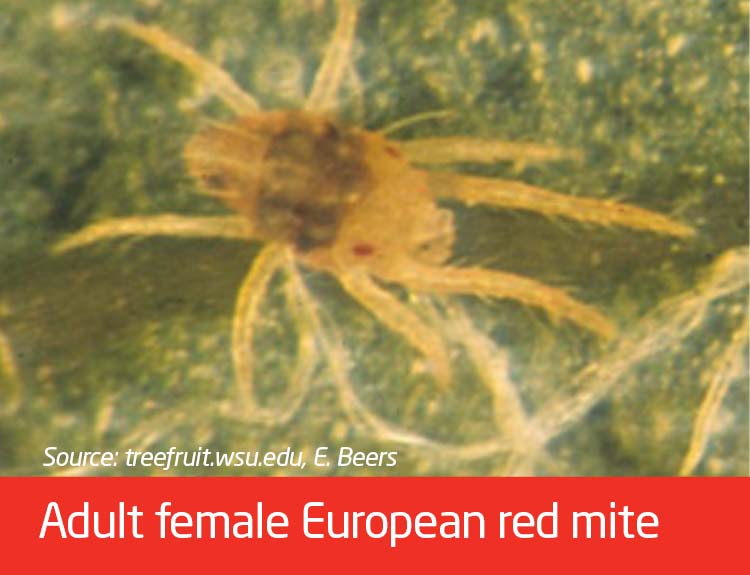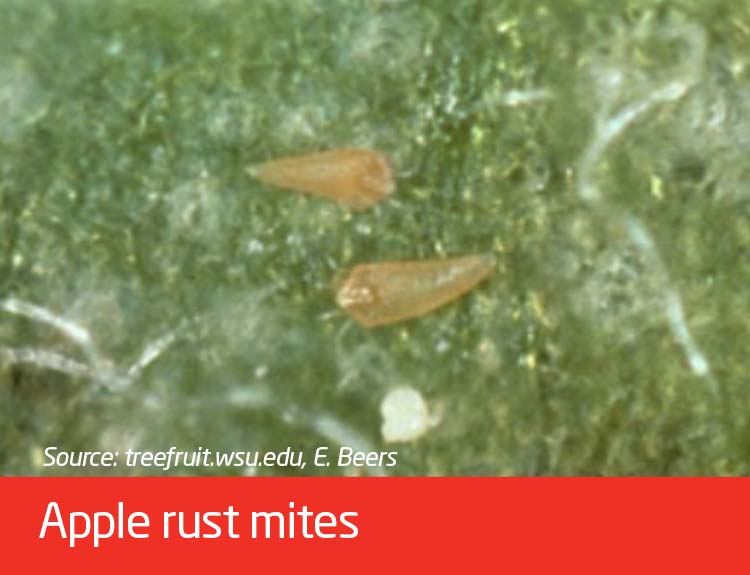Spider Mite and Rust Mite Control on Apples
November 08, 2021
Background
Mites are a common and important pest in apple orchards in the Pacific Northwest (PNW). In the right environment, mite populations can grow exponentially and, therefore, controlling them is important.
Spider mites (Tetranychidae) and rust mites (Eriophyidae) are both pests of apples. Spider mites are small (less than 0.5 mm long) and easier to see with a magnifying glass or hand lens, but can be seen with the naked eye. Spider mites produce characteristic webbing, a common sign that spider mite populations are high in an orchard. McDaniel spider mite, two-spotted spider mite, and European red mite may all present as pests in apple orchards in the U.S. In contrast, rust mites are more elongated, but only half the length of spider mites and thus require magnification to view. They have a wedge-like shape and two pairs of legs at the front end of the body.



Both spider mites and rust mites suck plant juices, but the symptoms are different. For spider mites, characteristic symptoms are stippling on leaves and browning (as leaves age or incur significant damage). For ‘free-living’ rust mites, e.g., apple rust mites, characteristic symptoms of their feeding are leaves taking a silver or brownish cast and russeting of fruit (in response to feeding on it), and for ‘gall-forming’ rust mites, e.g., appleleaf blister mites, characteristic symptoms are blisters that are originally red, but turn light brown to black and can be found on both foliage and fruit.
Life Cycle of Spider Mite—European Red Mite
The European red mite winters in the egg stage then the larva move to leaf surfaces, generally the lower side of the leaf, to feed. As foliage becomes mature, adults and immature mites are more likely to be found on those leaves (vs. young, newly expanded leaves). First adults will appear around petal fall in apple orchards.
Control of Spider Mites in Apple Orchards
In general, hot, dry weather favors the buildup of spider mite populations (and lack of overhead irrigation and/or dust favor outbreaks of two-spotted spider mite and McDaniel spider mite).
It is important to monitor spider mite populations in orchards. At a level of 30 mites per leaf, a treatment to curb the population is recommended to maintain optimal production, though growers or consultants may have their own thresholds based on experience and sampling technique.
One means of controlling spider mite populations is through predator mite populations. They can be effective, although they require at least a low-level spider and/or rust mite population for a food source.
Regarding chemical control, a delayed-dormant mineral oil spray should be used to destroy overwintering egg populations. In apples, this application will generally provide good control through May and into June. In-season sprays from June onwards should be used to keep spider mite populations under control. Miticides that are soft on beneficials should be preferred.
Life Cycle of Rust Mite—Apple Rust Mite
Apple rust mite overwinters as females in crevices on branches or twigs and under bud scales. They emerge in the spring and mostly feed on the underside of leaves as buds open in the spring. There are multiple generations through the growing season and warmer temperatures favor rapid development, although hot and dry conditions (95 oF and RH below 20%) curb the populations.
Control of Rust Mites in Apple Orchards
The presence of a large number of rust mites can be detected by the color of the leaves, and should be confirmed with a hand lens 10x or better (if a population estimate is needed, the brush leaf method should be used). They provide an important alternative food source for predatory mites, so control is typically not recommended unless populations are high in July and predatory mites are negligible to non-existent.
Blister rust mites, e.g., appleleaf rust mite, rarely infest well-managed apple orchards, however, they should be scouted and monitored if present. If necessary, treatments should be applied to control populations and applications are most effective after harvest when the mites leave the leaf blisters and move to terminal and fruit buds (where they remain exposed until buds swell in the following spring). Pre-bloom treatments can prevent damage that occurs during bloom as well. Again, miticides that are soft on beneficials should be preferred.
Recommendations: For control of mites as part of an overall IPM program in conventional and organic apple orchards:
- 1-2 gal/100 gal Tritek® (mineral oil) at delayed-dormant (1/2” green tissue) timing to destroy vulnerable spider mite eggs, and in-season as part of IPM program.
- 1-2 qt/100 gal Biomite™ for spider mite control during growing season. Do not apply with a surfactant. Biomite is easy on beneficial insects.
- 1-4 pt/100 gal BRANDT® Ecotec® Plus for spider mite or apple rust mite control during growing season, and/or blister mites post-harvest if/as needed. BRANDT Ecotec Plus is easy on beneficial insects.
